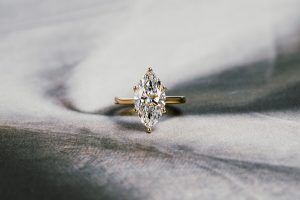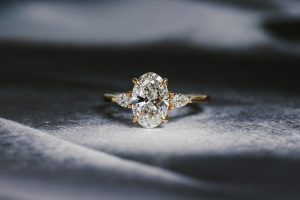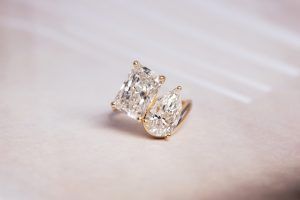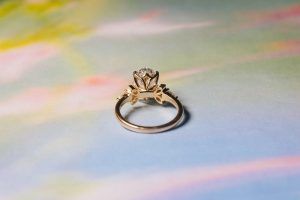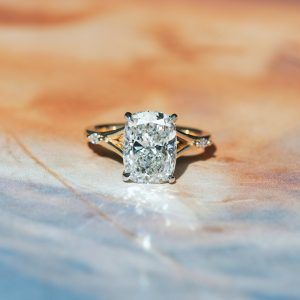
written by Jessica
How Much Should You Spend on an Engagement Ring?
Updated October 17 2025
Key Takeaways
- The “two-month salary” rule is outdated marketing, not personal finance advice.
- Use flexible frameworks (like the Budget Range, Style-First, and Blind Test methods) to find your comfort zone.
- Start with what feels comfortable now. You can always upgrade your diamond later through Engage Studio’s 100% trade-up policy.
- Think long-term: your engagement ring will be worn every day for life!
The Problem: Too Many “Rules,” Too Little Clarity
When starting the engagement ring journey, the question “how much should you spend on an engagement ring,” will inevitably come up and will get you hit with a flood of opinions. Some will quote the old two-month salary rule. Others will give you average dollar figures that don’t consider your life, your finances, or your priorities.
At Engage Studio, we’ve walked through many clients with this same question, and the truth is, there’s no universal number! Instead, think of it more as a framework that helps you find your comfort range while keeping the tension of heart vs practicality in a balance.
So let’s cut through the noise and build an engagement ring budget that works for you.

What is the “two month salary” rule?
The 2 month salary rule is a very common but very outdated guideline saying you should be spending 2 months worth of your income for the engagement ring. The rule actually started as a marketing campaign by De Beers after World War II, and they’re a mining company, not a financial advisor 🧐
Think about it practically.
People’s incomes, expenses, and cost of living vary wildly. The same diamond costs the same in Toronto or Kansas, but your rent, food, and savings goals definitely don’t.
At best, the two-month rule might serve as a loose sanity check. But as an actual budgeting method? It’s outdated. What matters far more is your comfort level, your partner’s values, and how this important purchase fits within your financial life.
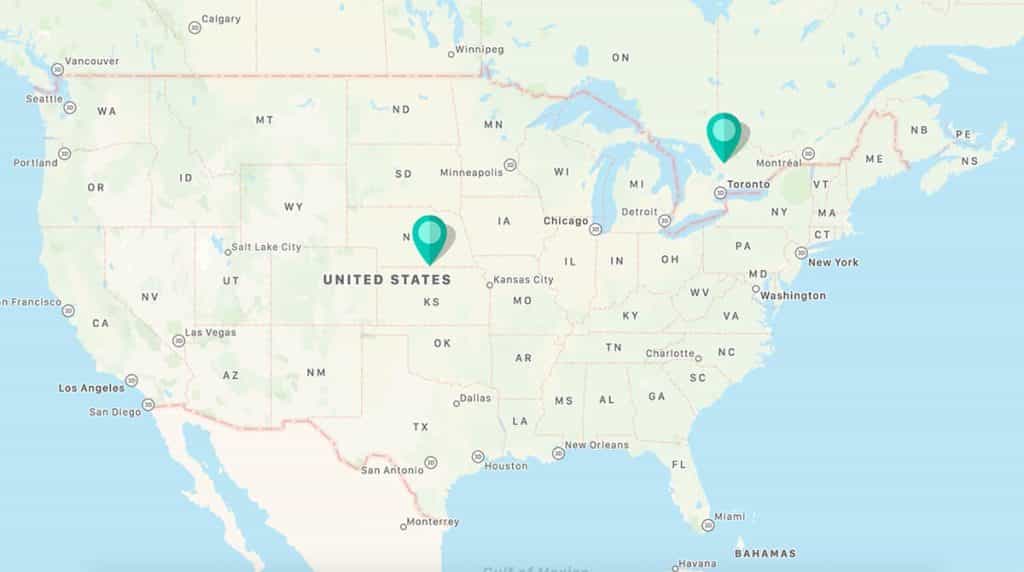
Three Practical Budgeting Frameworks At Engage
Every couple we work with approaches budgeting differently. We’ve built these three tried-and-true frameworks that will help you find your number, without the guesswork or guilt.
1. The Budget Range Method
This method works best if you already have a rough idea of the styles or stone shapes you like.
Start by choosing your broad budget range made up of the minimum and ceiling budget you’d be willing to go, for example $4,000 to $8,000.
Then, during your design consultation we’ll show you what each end of that range can get you side-by-side. You might find that $4,500 already delivers your dream look, or that stretching a little higher adds visible value.
It’s a cost–benefit analysis for the heart 💖
When you can see and experience how your dollar translates visually, it’s easier to decide whether it’s worth it. For many of our clients, this method transforms an abstract number into a clear, confident choice.

2. The Style-First Method
If you’re not sure where to start, this approach flips the order.
Forget the budget for a moment. Focus on style.
What’s the look that feels like her? Is it a solitaire? A three-stone ring with vintage motifs? A delicate pavé band with hand engraving at the bridge? Once you’ve nailed the aesthetic, we can build different versions of that look across price tiers: lab-grown, natural diamond, moissanite, and even colourful gemstones.

In the earlier generations, diamonds were seen as supreme and there was an obvious hierarchy when it came to engagement ring styles. Today, you have a world of options that can achieve the same look at dramatically different price points.
For example, let’s just say we’ve established that we want an oval shaped solitaire design:
- A 2 ct lab-grown oval will cost a fraction of a natural diamond of the same look.
- A moissanite at the same size will cost a fraction of the lab-grown diamond, with a completely unique rainbow sparkle.
- If she’s open to exploring colour, what kind of gemstone it is and whether it’s lab-grown or natural will vary vastly in terms of price point.
3. The Blind Test
This one’s our personal favourite, because in the process it allows you to activate your own senses.

Here’s how it works:
We gather your low to high range (the minimum you’d want to spend and the ceiling), your style preferences, and based off of that we curate a selection of stones you can compare side-by-side. The fun part is, you’re going into this without knowing the specs or the individual prices of the stones right away!
This way what you pick is purely based on what you’re naturally drawn to.
A lot of the time, the stone our clients end up picking isn’t even the most expensive one.
It’s because beauty is subjective. Some people are more sensitive to colour, others to sparkle, and others to proportions. The Blind Test lets your eyes (and heart) decide—without marketing labels or price bias.
Every stone we show fits within your budget range, so whatever you fall in love with is already a “yes.”

Buy Now, Upgrade Later
Here’s another way to think about how much you should spend on an engagement ring. To many, the engagement ring might seem like a “one and done”, but it doesn’t necessarily have to be!
At Engage Studio, our 100% trade-up policy lets you apply the full value of your current diamond toward an upgraded one anytime in the future.
It’s perfect for those just starting out in their careers, or anyone who wants the option to celebrate milestones later with a larger stone or new design.You can even start with a placeholder stone (like moissanite!) in your engagement ring setting, then replace it later when you’re ready.
We actually love the idea of the engagement ring being something you can grow into, and continue to grow as your marriage matures and grows.The ring would be based on that same foundational structure, but now with a new stone.
We’ve designed our custom process to be super flexible, so you can really take the time and necessary steps to design with the future in mind.
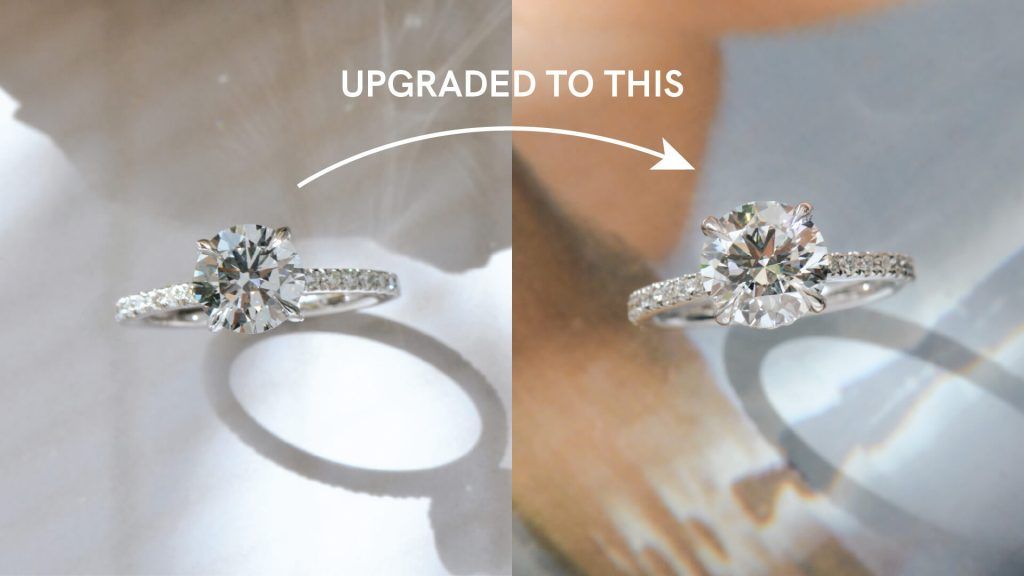
The Lifetime Value Mindset
If your partner will wear this ring every day for the next few decades, it’s worth framing the decision in long-term terms.
Think of it this way.
Most of us will end up spending more on a car or a house, and those things will change as time goes on. But the engagement ring will be something she wears every single day.
Find that healthy tension between heart and practicality:
- It’s okay to stretch a little for something deeply meaningful.
- It’s also okay to prioritize your financial comfort and upgrade later.
The right balance is the one that lets you feel excited—not anxious—when you open that box.
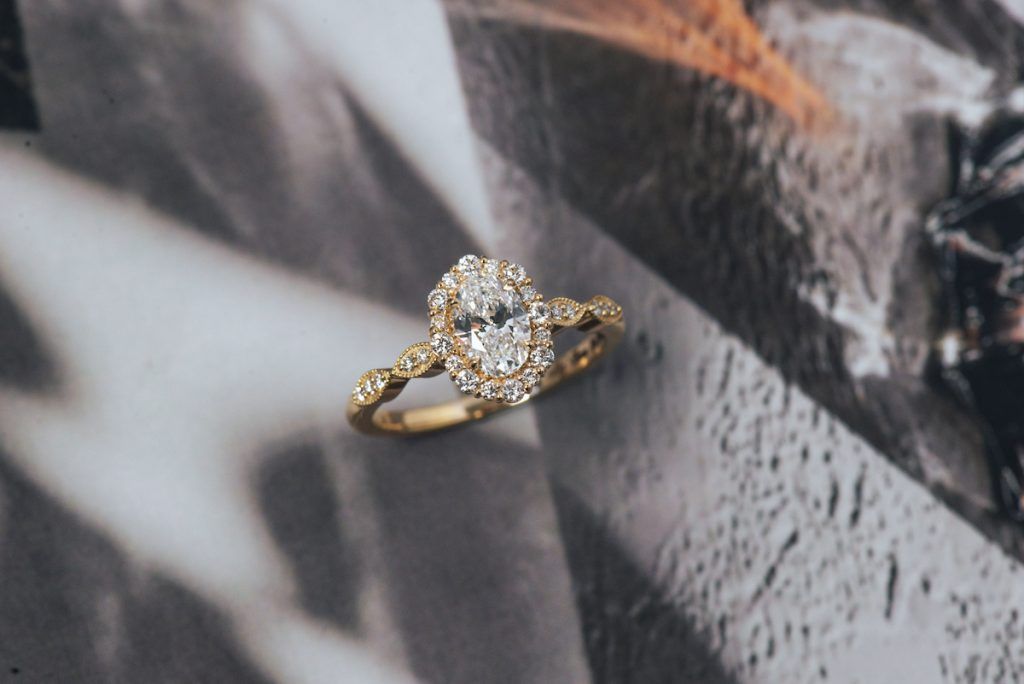
Don’t Buy Based On Carat.
This may be a shocking concept to some, but hear us out.
The carat concept is one of the most meaningless ways to determine the diamond you choose to invest in. We use the “4 C’s” as a guideline, but by no means the final deciding factor.
Take a look at these 3 stones below. They are visibly different sizes, yet they are all 1 carat.So can they appear so different? It’s because carat is a measure of weight, not size.

The engagement ring and diamond industry love to present the stone prices based on carat, which is why it’s the most common way diamonds are marketed. So we hear clients coming in all the time asking for a certain carat, which is understandable! But it’s super important to unpackage this diamond stereotype.
If you fixate so much on the carat weight, you’re going to lose out on being able to discover the diamond that is right for you. The sparkle, the size in proportion to your hand, how the colour sits with your skin tone, all the elements that truly matter.
Ready to Start?
When it comes to how much you should spend on an engagement ring, there’s no formula, only frameworks to guide you toward confidence.
If you’re ready to explore what’s possible within your budget range, we’d love to help you design your unique engagement ring.
Book a consultation (virtual or in-studio) and we’ll walk you through your options side-by-side designing style, size, and sparkle until we find the combination that feels just right.
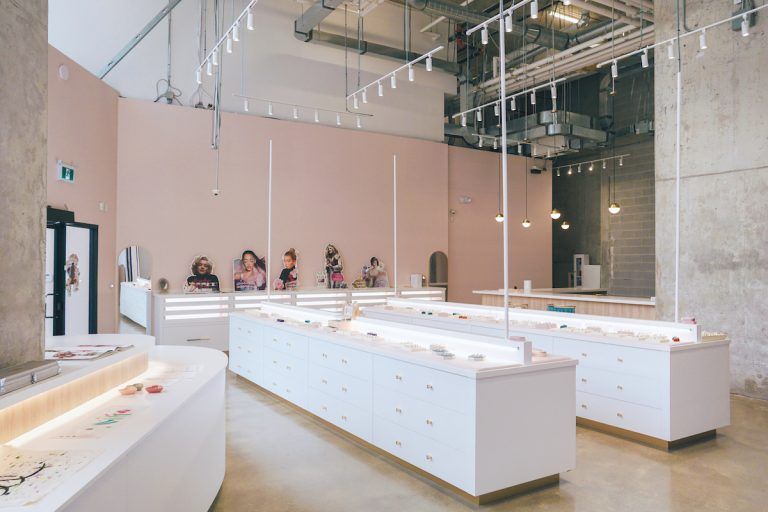
FAQs
- Is the two-month salary rule still relevant?
Nope. It was created as a marketing campaign, not by financial experts. - What’s a realistic engagement ring budget today?
Anything that fits comfortably within your current finances and preferences. We see couples spending anywhere from $2,500 to $15,000+, depending on their priorities, materials, and timing. - How do I get the biggest look for my budget?
Go for elongated shapes, and leverage the engagement ring style to bring focus to the stone such as not having shoulders. Consider the stone. Moissanite and other gemstones offer incredible value for the visual size.


